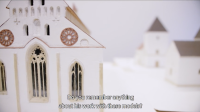The Nearest Point to the Free World, 1989
HD video, 32 min.
The architect Jonas Pajaujis, a member of the Lithuanian dissident community in Sweden and his best friend, painter Eugenijus Budrys, were two of the initiators of the Gotland study week, 31 July to 6 August 1989. Both living on the Island, they took charge of the organization of the conference at Katthamra Farm, located in Katthammarsvik. Gotland was the closest western territory to Lithuania during the Cold War, and that made it a strategic host shortly before the dissolution of the USSR. These study weeks had been held yearly in various countries for thirty-six years, including Britain, Germany and the United States during much of the Cold War. This year leaders of the Lithuanian People's Front, members of the Supreme Soviet of Moscow and Lithuania, Lithuanian intellectuals and leading exiles were all gathered at Katthamra Farm. For the first time the event was attended by representatives from Lithuania and the communist party. Dissidents came all the way from the USA, Switzerland and West Germany. In a barn behind the mansion discussions were held to exchange experiences on various topics; politics, economy, public health, literature, and religion. 100 people were participating overall in the conference and ten of them gave presentations.
The Youth Theatre was officially invited to Katthammarsvik to perform at the study week. Algirdas Latėnas read lyrics and poems by Paulius Širvys and Antanas Strazdas for example. When meeting with the actors, Algirdas Latėnas, Violeta Podolskaitė, Janina Matekonytė, they all mentioned that they were surrounded by an air of euphoria, the excitement of not knowing but awaiting a brighter future. On every trip they made they were being followed by a KGB agent, with the title of a “director”. But even on Gotland, Latėnas explains, everybody was being supervised, most of them were being used to it and being so close to the dissolution of the Soviet Union, it seemed rather to have been more of a formality, as there were representatives from the communist party present.
The actress Janina Matekonytė was during the whole week recording the event with her own camera. In my double channel video I used her documentation next to newly recorded material in a dialectical way, so that the different temporalities are overlapping visually. Her film material helped me to compare the information I received during the interviews with what I could see was recorded, functioning a bit like visual evidences. In one clip, a video camera zooms in on the social life on the boat. A young Latėnas hanging around in the boat smoking a cigarette while another man enters with a photo camera turning towards the video camera. They look very relaxed and I can sense the air of happiness. Violeta Podolskaitė describes it like: “It was the beginning of our new life in Lithuania. We were like the first birds”.
In travelling from Lithuania to Gotland they took an enormous risk as border guards were trigger-happy. Frequently they would shoot even at seals anytime they saw something suspicious on the horizon, Landsbergis states in the film. Still it is worth considering that in the summer of 1989 it might have become easier to cross the militarized border as Mikhail Gorbachev’s reforms toward openness had created a more tolerant atmosphere. Landsbergis points out that, “the regime pressure was already weakened, so they allowed what was unimaginaly before to sail with yachts across the Baltic Sea with no great problem with the border guards”. There were two boats crossing the Baltic Sea with actors from the Youth Theatre, accompanied by Landsbergis and the Communist representative Justas V. Paleckis as well as other peoples, which I do not mention here. Symbolically completing the same journey as their fellow countrymen had made previously, during and after World War II. In the edited documentation by Matekonytė, one can follow the journey on the boats and the boats in the habour. One can see happy faces, people singing and talking but not hearing exactly what they speak off and there is also a sound track of instrumental music describing those emotions.
The Gotland study week meeting was crucial as one of the links in a chain of many events preceding Independence and it took place shortly before the non-violent Czechoslovakian Velvet Revolution, and the fall of the Berlin Wall. As the Baltic Way happened shortly after the signing of the document, the Gotland meeting itself had soon passed away, it had served its purpose to unite the people and leaders on paper.
/Excerpt from catalogue Portable Landscape, produced by LCCA Riga.
Published in: Springerin, Echo gone wrong
Produced for: Portable Landscapes, Latvian Centre for Contemporary Art, Riga, 2018. With support from BAC.




